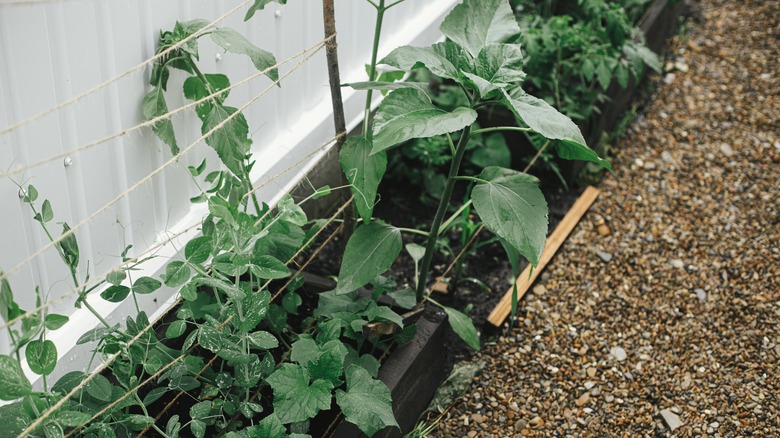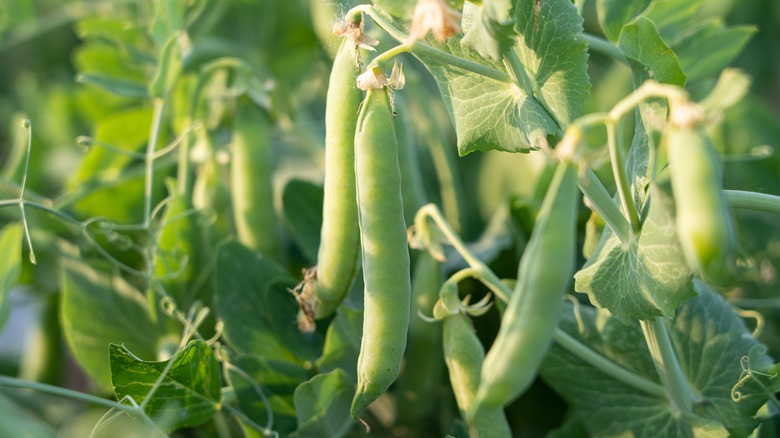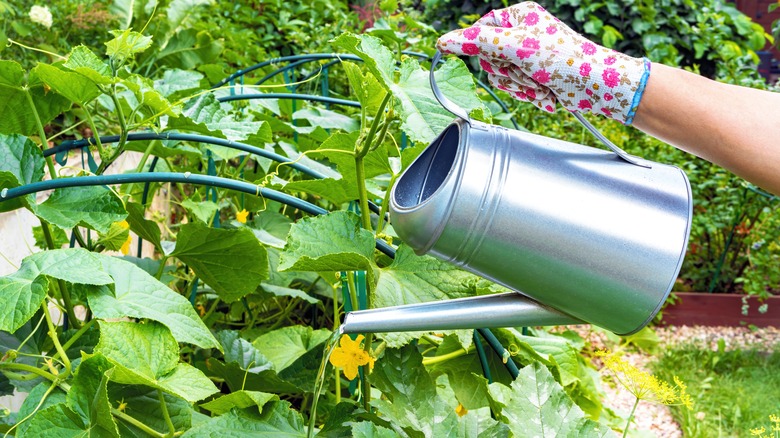Why Planting Cucumbers & Peas Together Are A Match Made In Vegetable Heaven
Peas (Pisum sativum) and cucumbers (Cucumis sativus) are both garden classics, and considering how delicious and productive they are, it's no surprise so many people opt to grow them. Peas are often thought of as good companion plants for cucumbers, and even if you're gardening in a small space, they can be good option. You can grow both cucumbers and peas vertically, with the peas enjoying the trellis during cool seasons and the cucumbers largely taking over during hotter summer months.
While not all companion planting recommendations have scientific evidence to support them, there are some compelling reasons to grow peas and cucumbers in the same space. Not only are the peas almost finished with their season by the time the cucumbers are ready to be planted, allowing them to easily share a trellis without crowding each other too much, but the peas can even help nourish the cucumbers. This is because, peas, as members of the legume family, are nitrogen fixers, meaning they are able to create usable nitrogen. While much of this nitrogen is used by the plant itself, some will remain in the soil and in their roots which you can allow to break down in place, providing additional food for your cucumbers.
Where and when to plant your peas and cucumbers
Both cucumbers and peas require full sun to grow well, so be sure to pick a sunny location for your pea and cucumber bed. You should also opt for a spot with well-draining soil that has a pH between 6 and 6.8. Both peas and cucumbers can grow in sandy soils if necessary, though they also do well in loamy and silt heavy soils. Be sure to test the health and pH of your soil to see how much, if any, fertilizer you should add.
While peas can be directly planted outside as soon as the soil is thawed in spring, you'll need to hold off on growing the cucumbers outside until all danger of frost has passed and soil temperatures are around 70 degrees Fahrenheit. If you live in an area with relatively short summers you may want to start your cucumbers inside and transplant them out once temperatures are warm enough, giving you a head start on the growing season. Cucumbers can also be direct sown.
Don't be surprised if your pea plants fizzle out just around the time the cucumbers start taking off: peas generally don't thrive once temperatures are about 85 degrees Fahrenheit. If you want to, you can plant another round of peas in late summer or early autumn once temperatures begin to drop again.
Popular pea and cucumber cultivars to grow
There are three types of peas you may want to consider growing — shelling peas, snap peas, and snow peas. If you have limited trellis space, you can opt to grow dwarf bush pea varieties which don't grow much past 2 feet tall. As peas only take around 60 days to reach maturity, you may be able to grow multiple rounds of peas in a year.
For cucumbers, you can opt to grow either slicing or pickling cucumbers depending on if you enjoy preserving your cukes or not. While many cucumber vines can grow to 5 feet long, smaller bush varieties also exist. if you're short on space you can opt to grow a compact cultivar like 'Spacemaster 80' whose vines only reaches around 3 feet long. Cucumbers usually reach maturity in around 70 days, so gardeners in areas with long summers can often grow two rounds of plants in one year.


